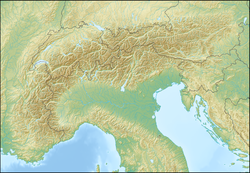|
1117 Verona earthquake
 An earthquake, rated at IX (Violent) on the Mercalli intensity scale, struck northern Italy and Germany on 3 January 1117.[1][2] The epicentre of the first shock was near Verona, the city which suffered the most damage. The outer wall of the Verona Arena partially collapsed, and the standing portion was damaged in a later earthquake of 1183. After the first shock of 3 January, seismic activity persisted for months, striking on 12 January 4 June, 1 July 1 October, and 30 December. GeologyThe earthquake, estimated at magnitude 6.5–7.0, was the largest in northern Italy. Its effects in the Verona region was devastating. The assigned maximum intensity on the MCS scale was IX. Damage in southern Germany and Pisa were initially attributed to this single event in the works of early scholars, however, they are now widely accepted that three distinct earthquakes occurred within the span of several hours. The first earthquake affected the towns of Augsburg, Dissibodenberg, Freising, Petershausen, Saint Blasien and Zwiefalten of Germany, and Melk and Salzburg in Austria. In Augsburg, several cantle collapsed. The collapse of a tower killed an unspecified number of people. The epicenter of this estimated magnitude 6.4 shock was in southern Germany. The earthquake that affected Verona occurred some 12 or 13 hours after the southern Germany event. A possible third shock occurred near Pisa with an epicenter area likely in the Serchio Valley. This shock toppled many towers and infrstructure. The timing of this event coincided with the Verona shock, however, there remains an uncertainty if this was truly a separate event. The maximum seismic intensity assigned was VII-VIII on the MCS scale. This earthquake was preceded by a non-damaging foreshock early in the morning.[3] DamageThe earthquake in Verona in 1117 was the strongest recorded in the history of northern Italy.[1][4] It was not only felt in Verona, but across northern Italy, from Cividale to Pavia, south to Pisa and north to Switzerland.[5] Outside of Verona, the most damaged areas were Milan, Bergamo, Brescia, Venice, Treviso, Modena, Parma, and Cremona. The main churches of Padua all suffered major damage. News of the earthquake reached Montecassino and Reims.[6] The Milanese chronicler Landolfo Iuniore reported that the church synods needed to be carried out in the open air due to the destruction. In Germany, damage was also extensive. The Michaelskirche in Bamberg, the abbey at Brauweiler, and buildings in Rottenburg am Neckar, Constance, Meersburg, and Fénis were all reported damaged.[7] Many churches, monasteries, and ancient monuments were destroyed or seriously damaged in Verona itself, eliminating much of Verona's early medieval architecture and providing space for a massive Romanesque rebuilding.[8] In the province of Veneto, many churches were severely damaged: in Brescia, Cremona, in the northern part of the Emilia plain and along the central route of the Adige river, and partial collapse of churches in Padua, Piacenza, Parma, and Modena.[9] See also
Notes
Sources
External links
|
||||||||||||
